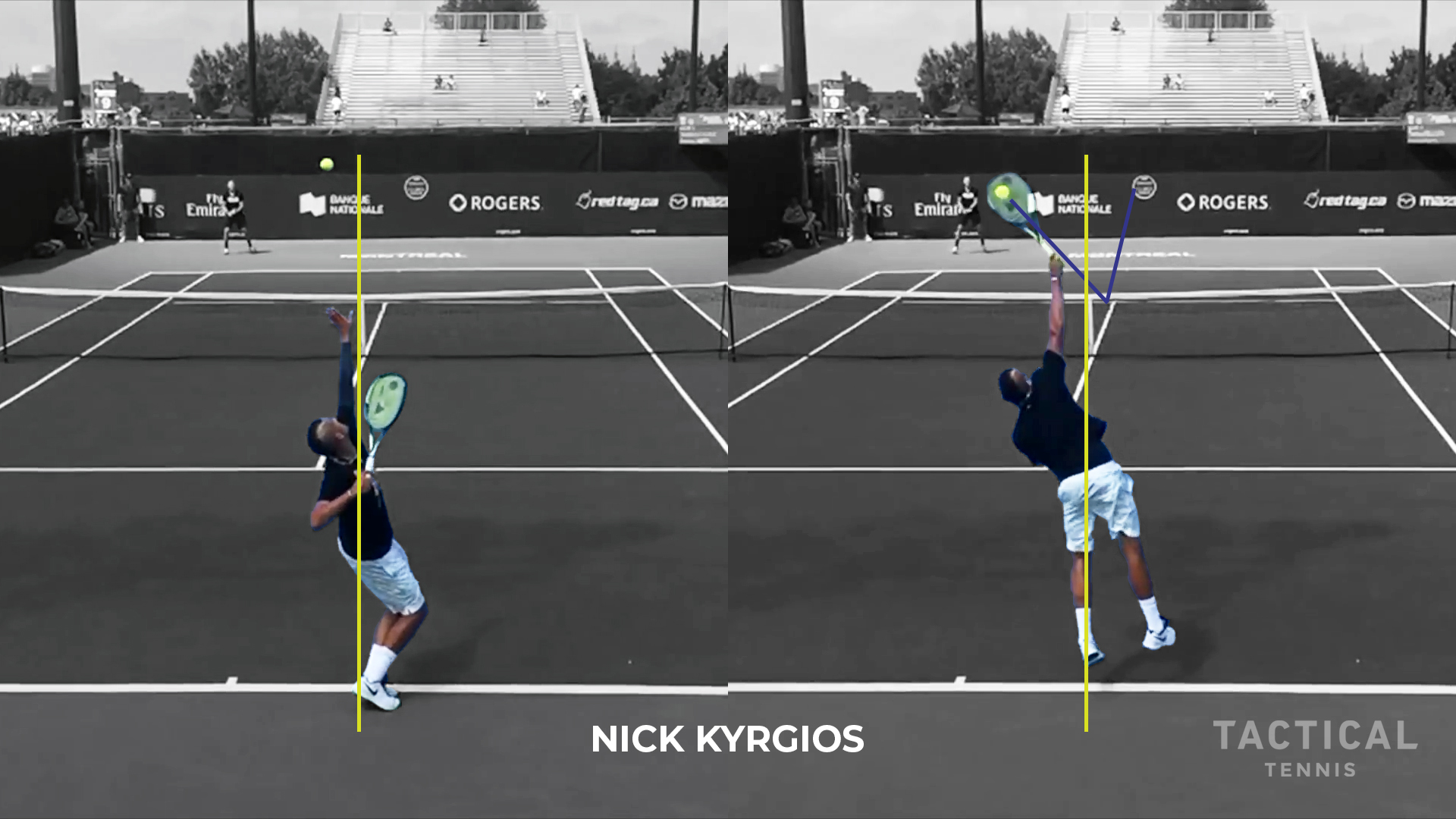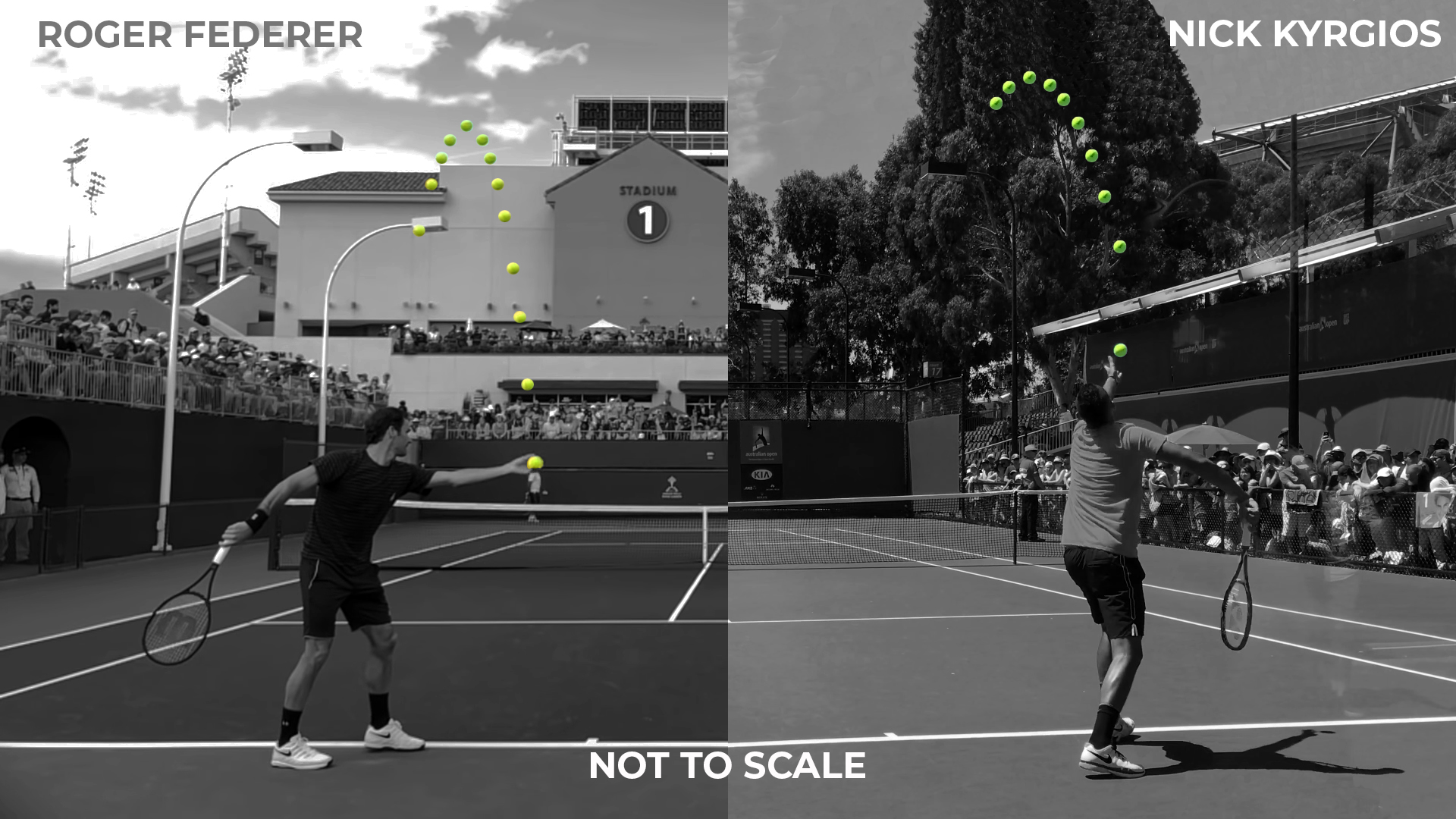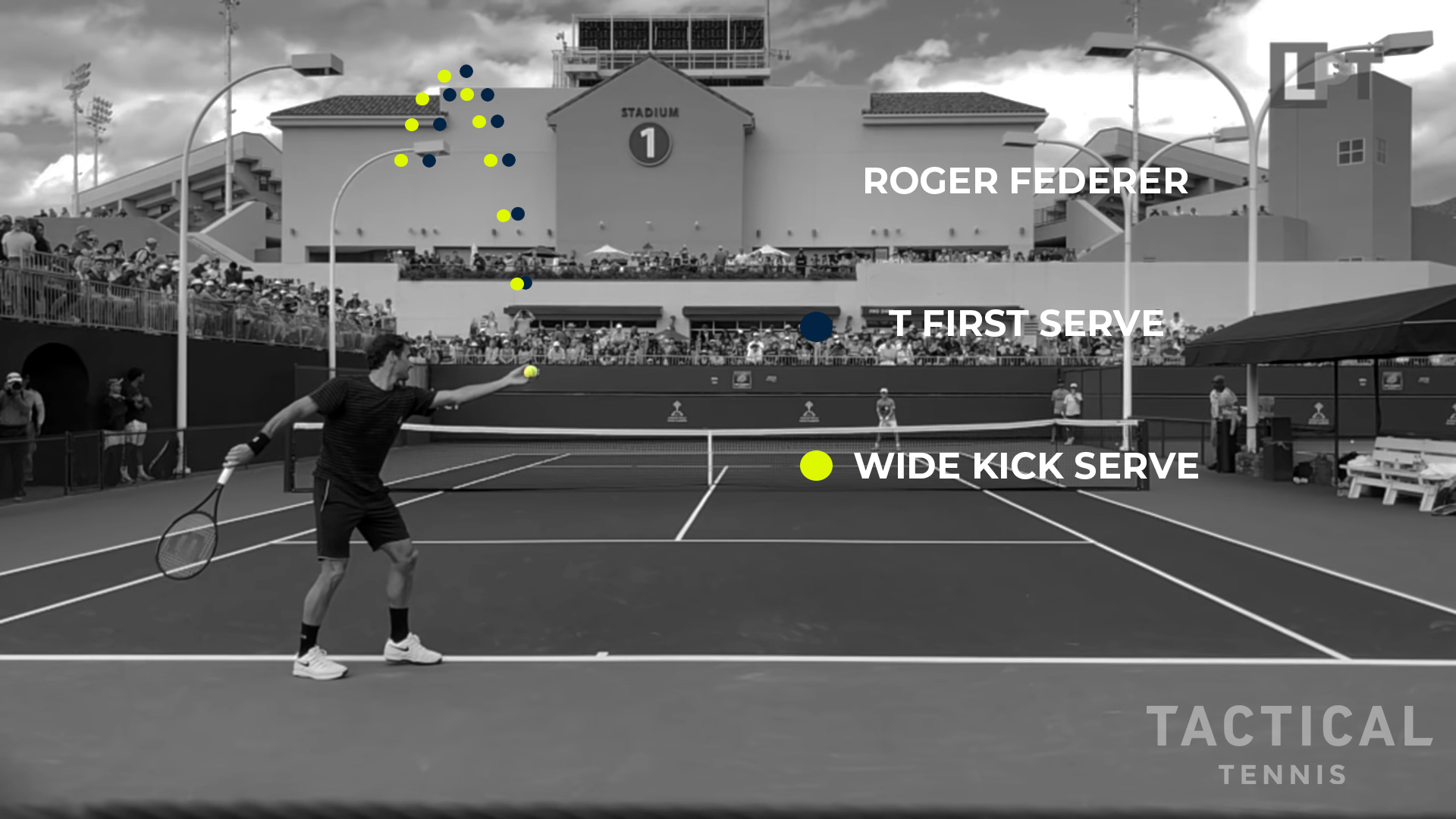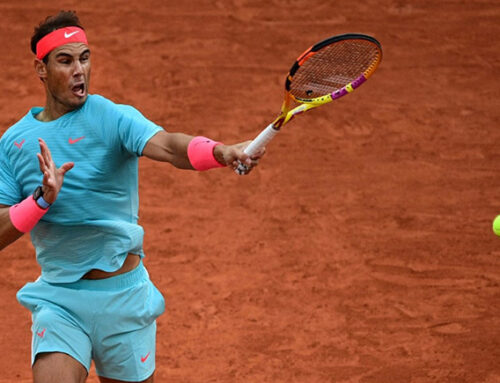Serving Mechanics: Ball Toss (Part Two)
Introduction
The optimal position of the ball toss is one of the common misunderstood elements of the serve. In part one we examined how far into the court the ball should be tossed. The misconception that tossing further into the court added significant power to the serve was addressed, showing that elite servers have a launch angle of between 78 and 85 degrees into the court.
In Part 2 we will look at the lateral position of the ball toss. If we know that the toss should be close to the baseline, now we will examine where along the baseline relative to our bodies we would want the ball to be.
The Goal
The goal of serving is to put as much energy into the ball as possible with accuracy and disguise. Some of that energy will be in the form of kinetic energy (velocity) and some of it in rotational energy (spin).

In order to maximize our energy transfer into the ball, we must make as complete a contact between the racquet and strings as possible. The further off-center we strike the ball, the more inefficient the energy transfer. Similarly, if we want the ball to travel forwards, but our racquet is moving to the side at contact, we will lose more energy at contact.
Where we toss the ball places limits on how we can hit the ball. It is possible to hit the ball in almost any direction from almost any toss, if we are willing to make a convoluted enough movement to do so.
Ultimately though, our ability to hit a high quality serve is directly impacted by our trophy position (which informs how we will swing at the ball), our toss location (which limits where we can make contact), and the direction we want to hit the ball.
These things dictate how much energy we can get into the ball and get it going in the right direction. They also impact how many different types of spins we can put onto it with the same toss.

Here we’ve taken the image above and moved the toss into different locations. For the sake of example, the left and right images are exaggerations of common ball toss mistakes. On the left, we can see that it becomes impossible to hit any slice on the serve and still serve with any power into the ad court.
On the far right, the only spin Federer could hit on the ball would be slice, and he would again not be able to put power on the serve. The middle image, the correct one, has the toss on a path that would let him serve to any part of the box with any desirable spin.
In both the left and the right images, the only way to get the ball to move in the correct direction is by reducing the quality of the contact, and hence the quality of the serve.
Lateral Toss Position
We will look at the lateral toss position at the point of contact for four players: Isner, Federer, Kyrgios, and Raonic. In all of these images, we will use the line of the left hip in the trophy position as a reference point for where the point of contact is on the serve.
Federer

Here Federer is about to power a heavily sliced serve up the T on the ad court. It will be surprising to many that for the slice serve Federer has the ball toss “so” far to the left. Many players (and teaching pros) think that to hit a slice serve the ball should be tossed out to the right so the player can cut the right edge of the ball. This is why so many players both lose significant power on their serve and they struggle to disguise their location.
Kyrgios

Again we see the toss to the left of the body line of Kyrgios. In this instance, Kyrgios hits a huge serve right up the “T” on the deuce court. Off this same toss however, he could just as easily have hit topspin slice wide, or a kick serve to the body. All of these options are available to him because of the toss location.
Isner

Isner’s toss location should look familiar by now. Similar to Federer in the first image in the series, Isner is hitting a big slice serve up the “T” on the ad court here. Again this is a toss location that many players would associate more with a second serve than a 135 mph delivery.
Raonic

When we look at Raonic’s toss location here it we see, not surprisingly, that it follows the same pattern. At contact the ball is well inside the line of his left hip in his trophy position, and yet from there he hits a ~140 mph serve up the “T”. Raonic could equally hit a slice serve wide with a lot of movement from this same toss.
The Arc
Now that we have a sense for where we want the ball to be, it’s time to talk about how to get it there. Tossing the ball is really quite simple. If we put a basketball 3-4 feet above your head, and asked you to hit it with a tennis ball you’d hit it basically every time. That’s the kind of space we need our toss to go through. Simple enough, right? So how do elite servers do it?

One thing that we see commonly among almost all elite serves is the arc of the ball toss. The ball isn’t just traveling a short distance forward towards the net as it rises, but also traveling across the body of the server.
It is important to note that the two images above differ in both perspective and scale. It isn’t intended to compare the height of Federer’s toss with the height of Kyrgios’ – in truth they make contact at very similar heights off the ground (around 10 feet).
It does show us two things:
- Both players arc their ball toss from left to right
- Kyrgios makes contact much closer to the peak of his ball toss than Federer does
Let’s take a closer look at these two players, and the difference in their tosses between first serves and second serves.
Federer’s Toss

Federer releases the ball with his tossing arm almost straight across his body, near parallel to the baseline. His release point is the same for both first and second serves, and the tosses follow a remarkably similar path. There is only a small difference between the position of the ball at contact for a powerful serve up the “T”, and a wide kick serve.
This speaks to Federer’s ability to disguise his serve so well. If Federer were hitting the wide serve with power, the toss would imitate the “T” power serve position exactly – it is almost impossible to tell where he is going to serve the ball based on the toss.
By extending the tossing arm across the body, Federer is also priming his body to move to a closed position, helping to rotate his torso away from the net. Doing so sets Federer up to maximize his vector of attack to the ball for spin and power, while also improving his disguise.
Kyrgios’s Toss

Nick Kyrgios’ toss provides an interesting counter-point to Federer’s. We can see here that the trajectories of Kyrgios’ first and second serves here are basically identical. However, Kyrgios actually tosses the ball lower for his power serve up the “T” on the deuce court than he does the body kick serve. Notice that the contact points are almost identical?
As mentioned above, Kyrgios also makes contact with the serve much closer to the top of the ball toss than Federer does. In the same way that Federer’s service motion allows him excellent disguise, Kyrgios’ quick motion achieves the same.
The human brain is excellent at pattern recognition. It is capable of distinguishing small differences in things it is familiar with very quickly. There are limits however. When Nick Kyrgios serves, he allows his opponents less time between the release of the toss from his hand until contact with which to read what is taking place. This might only amount to a fraction of a second, but at the time scales we are talking about that fraction of a second can make a significant difference.
It is also worth noting that more than any other player on tour, Kyrgios has a large amount of variety in the ball tosses he uses. Nick is as likely to hit a 138 mph serve up the T on the ad side off a ‘kick toss’ as he is to hit an actual kick serve. It is less useful to compare his “first” and “second” serve tosses to each other than most other players. We do have the two important takeaways though:
- Kyrgios makes contact much closer to the peak of his ball toss than most players
- This allows his opponents less time to read the serve and react
Conclusion
The serve is, as we’ve noted previously, a very complex movement. The toss is ultimately a very simple movement. The true struggle for most people when it comes to the ball toss isn’t really an inability to put the ball through the correct space, it’s a misunderstanding on what the correct space is.
When we focus on getting the ball into the place that allows our body to move into better positions, then our quality of serve improves. We toss the ball close to us and high, to allow for better elevation. Better elevation improves our margins on the serve, and who doesn’t wish they were John Isner when it was serving time? Power doesn’t come from jumping forward – we can get better quality power from elsewhere in our service motion!
Laterally, we want the ball inside the line of our lead hip (left hip for right handers, right hip for left handers) on the first serve. Moving the ball too far to the right or left of this restricts the types and quality of spin we can put on the ball. The second serve toss should be almost identical to the first serve toss. It might be that your current motion limits your ability to do this and make good contact – a sign that there are other problems that also need addressing!
Ultimately, the focus is on improving the quality of the serve on both first and second deliveries. In order to do so, we have to put the ball in a space that allows us better vectors through the ball at contact. The toss cannot force us to hit better quality, but a poor toss can prevent us from doing so.



